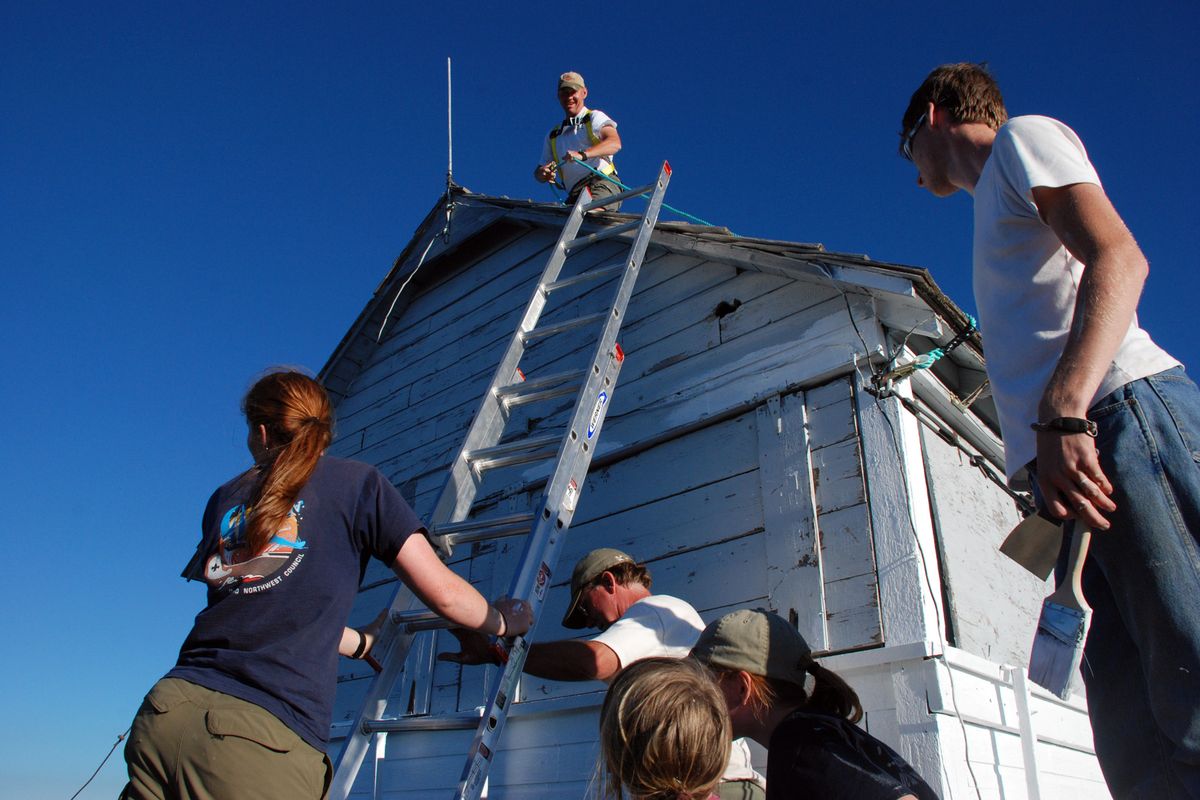Cliff hanger
Volunteers high on maintaining Mallard Peak lookout

Perched at 6,870 feet on the divide between Idaho’s Clearwater and St. Joe rivers, the Mallard Peak lookout has rarely been unoccupied since it was last staffed by Forest Service fire monitors in 1957.
Critters are year-round guests and humans trickle into the site weekly during the summer and autumn when snow doesn’t clog the trail.
The lookout’s logbooks are filled with more than 50 years of tales from backcountry travelers who’ve taken advantage of a free 14-by-14-foot room with a view.
They tell of night skies streaked by meteor showers and terrorized by lightning. Entries recount morning greetings from mountain goats and midnight raids by mice, of cozy evenings by the oil lamp and chilling ordeals without enough dry wood for the small stove.
Bear, deer and elk sightings are regularly recorded along with fishing exploits at nearby Heart, Skyland and Northbound lakes.
Visitors have been thrilled by the chirps of pikas in the talus slopes below the lookout and not-so-thrilled by the seasonal lady bug infestations inside the 80-year-old shelter.
Hikers and equestrians must trek seven miles into the Mallard-Larkins Pioneer Area to reach Mallard Peak, yet some of the visitors have invested considerable time nursing the aging ground-level cabin.
They’ve swept out the house-fly carcasses and rodent droppings and packed in tools, hardware and ladders to replace windows, pound nails, fasten cables and button up shutters.
Four years ago, however, Richard Fuller of St. Maries hiked into Mallard Peak after spotting the lookout from the deck of the Surveyor’s Ridge lookout, which he and his wife had booked as a rental that could be accessed by vehicle.
After making the trek to Mallard, he found a letter that spurred him beyond recreation and into action.
The note had been written by electrician Tim Grubham, another St. Maries resident whom Fuller had met when they both worked at the Potlatch lumber mill.
“Tim wrote to tell the next visitors that he’d been trying to fix the shutters until a bad storm forced him to quit,” Fuller recalled. “He was simply asking the next people to finish up, as long as they weren’t afraid of heights.”
Fuller was motivated after calling Grubham and learning that his family had been maintaining the lookout for years but were losing the battle to the structure’s age and exposure to the elements.
He began calling Idaho Panhandle National Forest officials, lookout buffs and backcountry horsemen to drum up interest in restoring the lookout.
Recently, a group including Fuller, Grubham, and Forest Service staffers installed a new door shutter, window shutters on three of the four sides and touched up the paint. It was the third significant work party in the past three years.
“There’s more to do, but the Forest Service has really taken an interest and it’s coming along,” Fuller said.
“It’s a good example of what can happen when there’s local interest to steer things in the right direction with an agency,” said Gary Weber of Coeur d’Alene, an officer in the Forest Fire Lookout Association and volunteer on many lookout projects.
Fire lookouts rank high in the Idaho Panhandle National Forest historical preservation efforts because they’re so visible and popular with the public, said staff archeologist Sarah Wilson, who was among the crew working on the lookout in mid-August.
“We have a lot of sites to think about, but when people are passionate about something and willing to volunteer to help, it gets our attention,” she said.
Wilson and Steve Matz, the Panhandle’s forest heritage manager, traveled to Missoula last winter to build windows and shutters at the Forest Service shop with the regional Historic Preservation Team, which is dedicated to restoring historical features to original specifications.
Parts for eight shutters using the 1928 materials list and 1948 photos of the window shutters were cut out and primed, Matz said.
Shutters were assembled using galvanized, slotted wood screws instead of pin-nailing – that is, nailing through the board and onto an anvil to drive the points back into the board – so the shutters would be easily repairable.
Mallard Peak lookout was designed in 1928 and built in 1929 as prototype to the L-4 cabin-style lookout used in other areas.
“We have the original plans and we try to be as historically accurate as possible,” Wilson said. “But there’s been a lot of improvement to lookouts since then, often for very good reasons.
“The prototype is quirky. That’s part of its character, but in some cases we may have to step back from historical accuracy to make sure the old lookout doesn’t fall down.”
This winter, forest staffers will try to figure how to deal with sagging walls that prevent sliding windows to function.
“The windows were designed to slide so you can open and close the shutters from inside the lookout,” she said. “That’s very important, especially on the east side, which is over a cliff.
“Our goal will be to keep any changes from being visible. When a visitor walks up to the lookout we want it to look the way it was in 1929.”
Most of the tools and materials for lookout restoration are packed in by forest crews or volunteers, either on foot or using stock.
That’s how it’s always been, including the last extensive restoration at Mallard Peak in 1981 by former lookout staffer Don Davis and Spokane lookout buffs Ray Kresek and his son, Dave.
Occasionally the Forest Service recreation staff teams with the fire staff to swing a load of materials to the lookout by helicopter, as they did this month with the pre-made and primed shutters, Wilson said.
Some fixes are authentic even though they’re not the work of a craftsman. Lookout buffs smile when they see woodpecker holes have been covered with lids from canned foods.
“That’s the kind of improvisation typical of lookouts,” Matz said.